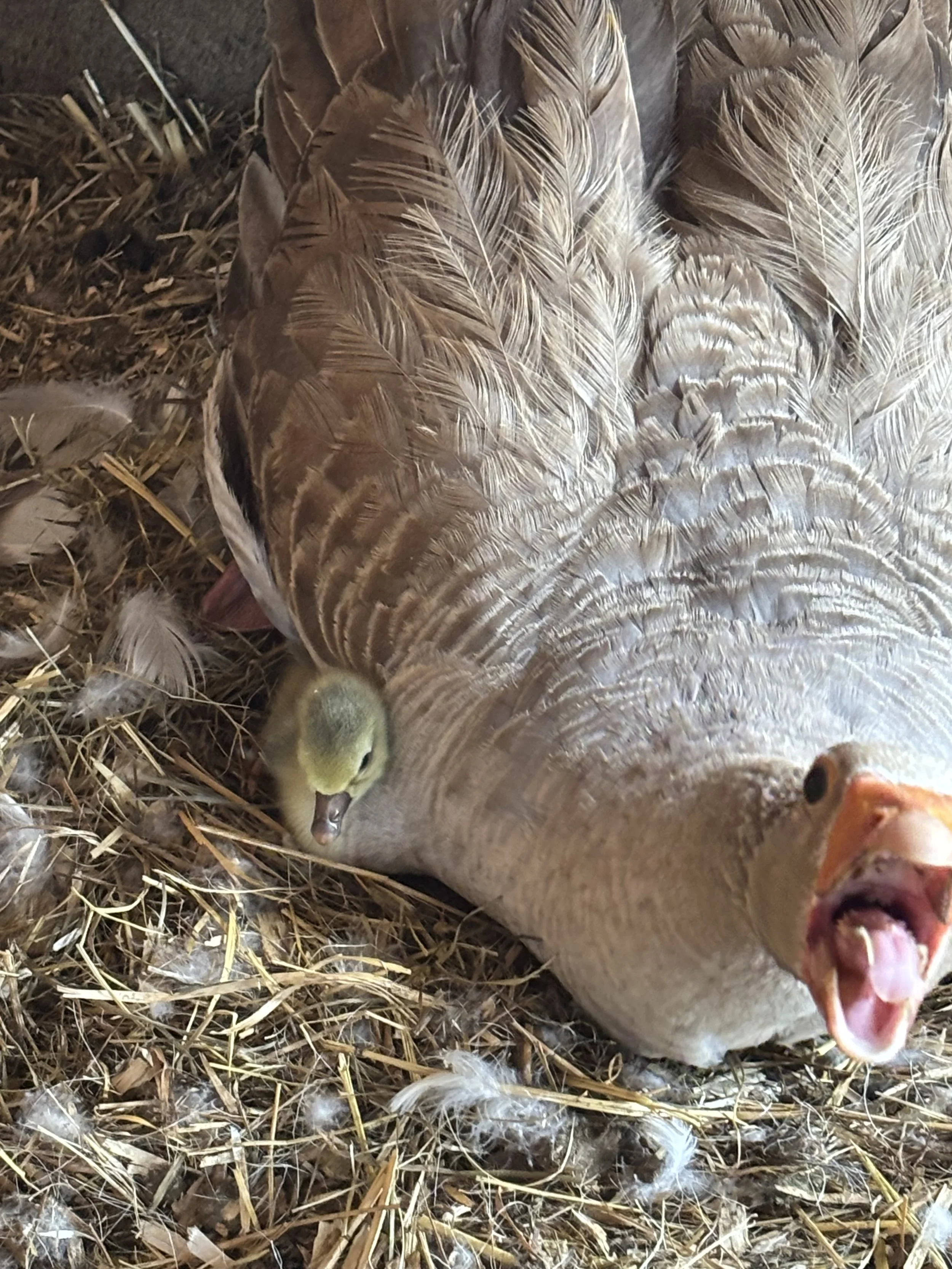Life Lessons on the Farm: What Animals Can Teach Us About Stress (and Why It Might Be Affecting More Than You Think)
Mother goose spreading her wings protectively over her goslings, illustrating instinctive stress responses and vigilance in animals.
By Wandering Willow Psychotherapy | Somatic & Trauma Therapy in Ontario
Life on the farm is full of lessons about the body.
Animals don’t hide stress the way humans do — it’s visible in every movement, breath, and sound.
When the goats are overwhelmed, they shake, pace, or bellow.
When the horses are tense, you can see it ripple down their backs like a wave.
And when the danger passes, they release it — a sigh, a shake, a flick of the tail — and then they go right back to grazing.
That’s what regulation looks like.
It’s not about never getting stressed; it’s about knowing how to return to balance.
When We Lose Touch with Our Stress
In contrast, humans are experts at pretending we’re fine.
We hold our breath, tighten our shoulders, and say,
“I’m not stressed — just tired.”
“It’s been a lot lately, but I’m fine.”
I hear it all the time in therapy.
Sometimes it sounds like anxiety, sometimes exhaustion or irritability — and sometimes it sneaks in through places people least expect, like sex.
Because here’s the truth:
When your body is stuck in stress mode, pleasure, connection, and even orgasm become physiologically harder to reach.
You can’t move toward pleasure when your body still thinks it needs to run.
The Science Behind It
When the body is stressed, the nervous system shifts into survival mode — blood moves away from digestion, rest, and reproduction, and toward the muscles and heart.
It’s brilliant for escaping danger, but not so great for feeling desire, safety with a partner or relaxing.
If this sounds familiar — feeling disconnected from your body, rushing through moments, or having a hard time “reaching the finish line” — it’s not a sign of brokenness.
It’s stress physiology.
Why We Stop Noticing Stress
Our bodies are built to send us signals — hunger, thirst, rest, excitement.
However, when those signals are ignored, they eventually fade away.
If every time your body says, “I’m tired,” you push through,
or “I’m anxious,” you say, “I’m fine,”
The body learns there’s no point in speaking up.
Eventually, it stops sending signals as clearly — until the stress shows up in other ways:
Trouble sleeping
Muscle tension
Digestive issues
Low libido or difficulty with arousal
The body always finds a way to communicate — even if it has to get loud about it.
What Animals Remind Us
Animals never ignore their cues.
They eat when they’re hungry, rest when they’re tired, and shake when they’re scared.
They don’t judge their stress or try to “push through” — they just let their body do what it needs to do.
Recently, I watched one of our geese sitting on her nest (so I obviously took a picture, lol!), with her feathers fluffed and her eyes sharp. She was visibly stressed, protecting her baby from what she saw as a threat — me, standing too close with my camera.
The moment I stepped back, she settled almost instantly. The tension melted away, and she returned to calmly guarding her gosling.
It reminded me how we all have a “mama goose” part inside — the one that flares up when something precious feels unsafe.
Sometimes that protective part becomes overactive, snapping or attacking when all it’s really trying to say is, “Don’t hurt what’s vulnerable in me.”
That’s the thing about stress: it’s not the enemy. It’s protection. But when protection never turns off, it becomes exhausting — for us and for the people around us.
“Even our inner mama goose needs to know it’s safe to rest.”
Reconnecting to the Body
Therapy often starts by rebuilding that connection.
We notice what your body is saying — tension, breath, temperature, posture — and learn how to respond instead of override.
Over time, those signals get stronger again.
You start to feel your hunger, your rest needs, your boundaries, and yes — your pleasure — more clearly.
Because the more you listen to your body’s “I’m stressed,” the more it trusts you enough to also tell you, “I’m safe.”
Want to Learn More?
If you’re curious about the mind–body connection and how stress lives in the nervous system, a great starting point is The Body Keeps the Score by Bessel van der Kolk, M.D.
It’s an accessible read on trauma and how the body holds — and can release — stress.
If you prefer something more somatic and practical, try Waking the Tiger by Peter Levine or Anchored by Deb Dana, which explore how the nervous system finds safety again after chronic stress.
If you’ve been feeling disconnected from your body — from stress, exhaustion, or even in moments of intimacy — therapy can help you rebuild that connection safely and gently. Together, we can help your body remember that it’s safe to feel again.


